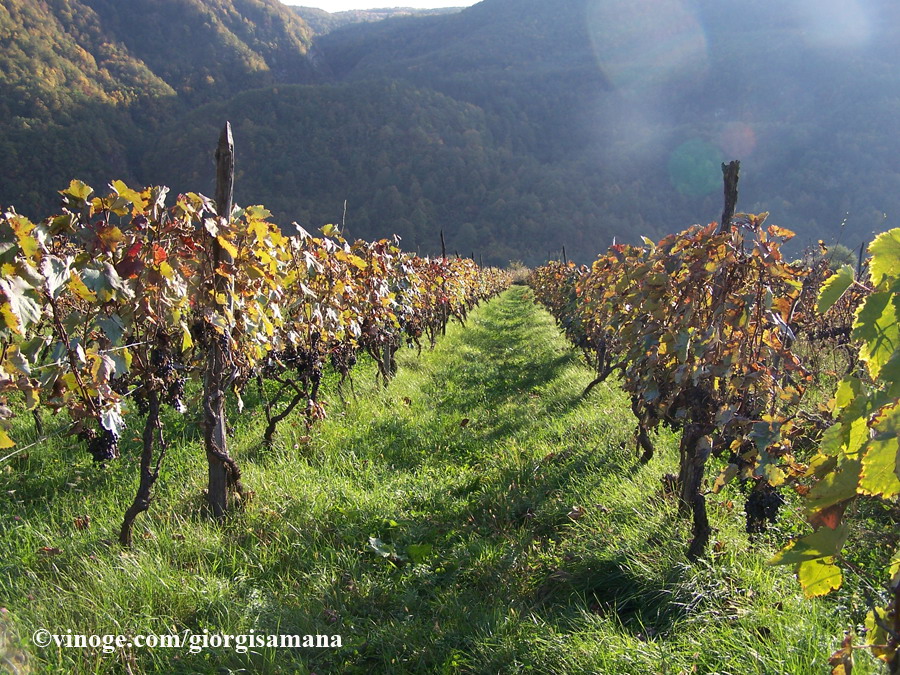
by Malkhaz Kharbedia
I can say that I’ve been acquainted with grape-growing and wine-making traditions of this region since childhood. 2-3 times a year we would visit Zeda (upper) Shavra village of Racha, my mother’s homeland. Our vineyards with Tsolikouri, Rachuli Dzvelshavi and Aleksandrouli grape varieties were located in Kveda (lower) Shavra, while we made wine in our own cellar, traditional wine press (Satsnakheli) and poured the juice in Churi (clay pots) in the ground under a small pavilion. Sometimes we sent back the juice in the wine press and left for final fermentation.
It is because of Valiko Dvali, my grandfather that vine and wine has become an important part of my life. My first lessons came from Racha wines and therefore, before I tasted Kakhetian or imeretian qvevri wines (qvevri=Churi in Imereti), or branded wines of 80-ies, my views of Georgian wines in general came from Racha wine standpoint.
Racha covers large portion of Ambrolauri district as well as Oni district. Vineyards are mainly located in the gorge of Rioni river, on its left and right banks (better quality vines are produced on the southern slopes of the latter). In lower Racha the most important is “Khvanchkara” micro-zone. On paper it covers village Tsesi all the way to Kvishara, but in reality, this area is much smaller. Main villages are Sadmeli, Gviara, Bostana, Didi Chorjo, Patara Chorjo, Meore Tola, Pirveli Tola, Chrebalo, and others. In terms of soil, Racha mainly has humus-carbonate and clay soils as well as limy soil, flint mixed with clay and sand with clay. These types of soils even have special names (Tiri-soil, Lisi-soil, Khorkhi-soil, Akhalo-soil, etc). The climate is humid enough, with average cold winters and hot, relatively dry summer.
Unlike Kakheti, Racha only has vineyards on a small territory, but this region is distinct with quality grapes and deep, sophisticated wines. Almost all types of grapes in Racha are of local origin. The most common are Tetra of Tsulikidze (Tsulikidzis Tetra) and Tsolikouri of white varieties, and Alexandrouli, Mujuretuli and Rachuli Dzelshavi of red varieties.
As Kotsia Ratiani of Chorjo village once told us, 30-40% of all grapes in Racha are Dzelshavi, but more Alexandrouli and Mujuretuli vineyards are common for Khvanchkara village. Population of Kvanchkara is not even interested in other varieties, but there are exceptions as well. For example, as Kolia Tkeshelashvili from Kvanchkara village says, if you mix other grapes with Alexandrouli, for example, Tavkveri or Ojaleshi, you may end up with wine of more sophistication and high value. According to one of the versions Shavi (Black) Kapistoni and Saperavi of Kakheti was also used for making classic Khvanchkara, as it was considered that more quality grapes were added to the blend, more exquisite the wine would become. This principle is well known in Bordeaux wineries, which mainly operates on four main varieties, and most distinct is Châteauneuf-du-Pape, which may have 4-13 varieties of wine materials mixed together.
In the 19th century Gustav Rade, a German scientist also praised wines of Bugeuli village. Exquisite wines were also produced in Khimshi and Tsesi villages using Rtskhila grapes, and Shavi (Black) Kapistoni in Bugeuli village. Tetra, Mtsvane and Tetri Kapistoni grapes were used to make quality white wines. There were frequent cases of using several varieties at the same time. Such wines are still common in Racha. Kotsia Ratiani that I mentioned above still makes wine using Tetra of Racha, Kikhvi and Mtsvane and says: “It’s so much better together. They’re not that great separately.”
Of course, Racha became famous due to Kipiani Princedom. Wine made of the grapes grown in this small area is still referred to as “Khvanchkara” (produced under this name since 1932). However, it was absolutely different before, and was distinct from current Khvanchkara in technological terms. Traditional, old Alexandrouli was made using folk methods, which was later adopted by Kipiani family and successfully marketed to Georgian and international markets. During the 19th century Khvanchkara wines of Kipiani vineyards were considered to be the best wines of the province. Experts of that time compared “Kipiani wine” to Burgundy wines due to its delicacy and velvet touch. Successors of those wines are still very popular in Georgia as well as abroad.
Best plots (territories) in Khvanchkara village are Patara Chala, Sapineebi, Satsavi, Nakhorebi… People of Racha fertilize soil for the vineyard as well, and apply manure once every 3-5 years. They even seed lucerne in vineyards along with other fabaceae family plants to enrich the ground with azoth.
Traditional winery of Racha, similar to Kakheti, Kartli or Imereti, includes wine press and Kvevri (clay pots), referred to as Churi in Racha. Previously, after pressing the wine the juice would go into Churi, and later returned to wine press together with skin and stones. The wine press would be covered with boards and left for first round of fermentation. After couple of days the juice would be sent back to Churi (even today, in the cellar of Kolia Tkeshelashvili, the fermentation happens in Khorgo (traditional wine press, like Satsnakheli) “but sometimes it does not finish fermenting there, and completes the action in Churi”). More frequently the juice underwent the complete fermentation in Churi. Three times a day the wine would be stirred, and as the fermentation finished, the wine would remain in Churi together with skin and stones, and would be sealed and kept until the next spring.
Grape varieties of Racha:
White: Tetra of Tsulikidze, Tetri Aleksandrouli, Beraula, Tetri Arabeuli, Tetri Kapistoni, Kudurauli, Meliskudi, Mtsivani of Racha, Mtsvane of Racha, Sakmevela, Khikhvi of Racha, Sadmeluri.
Red: Aleksandrouli, Mujuretuli, Arabouli, Tkhmorula, Kapistoni, Machanouri, Mokaturi, Makutvneuli, Natsara, Rtskhila, Khoteuri.
© vinoge.com
Translated by Tamuna Kvaratskhelia






